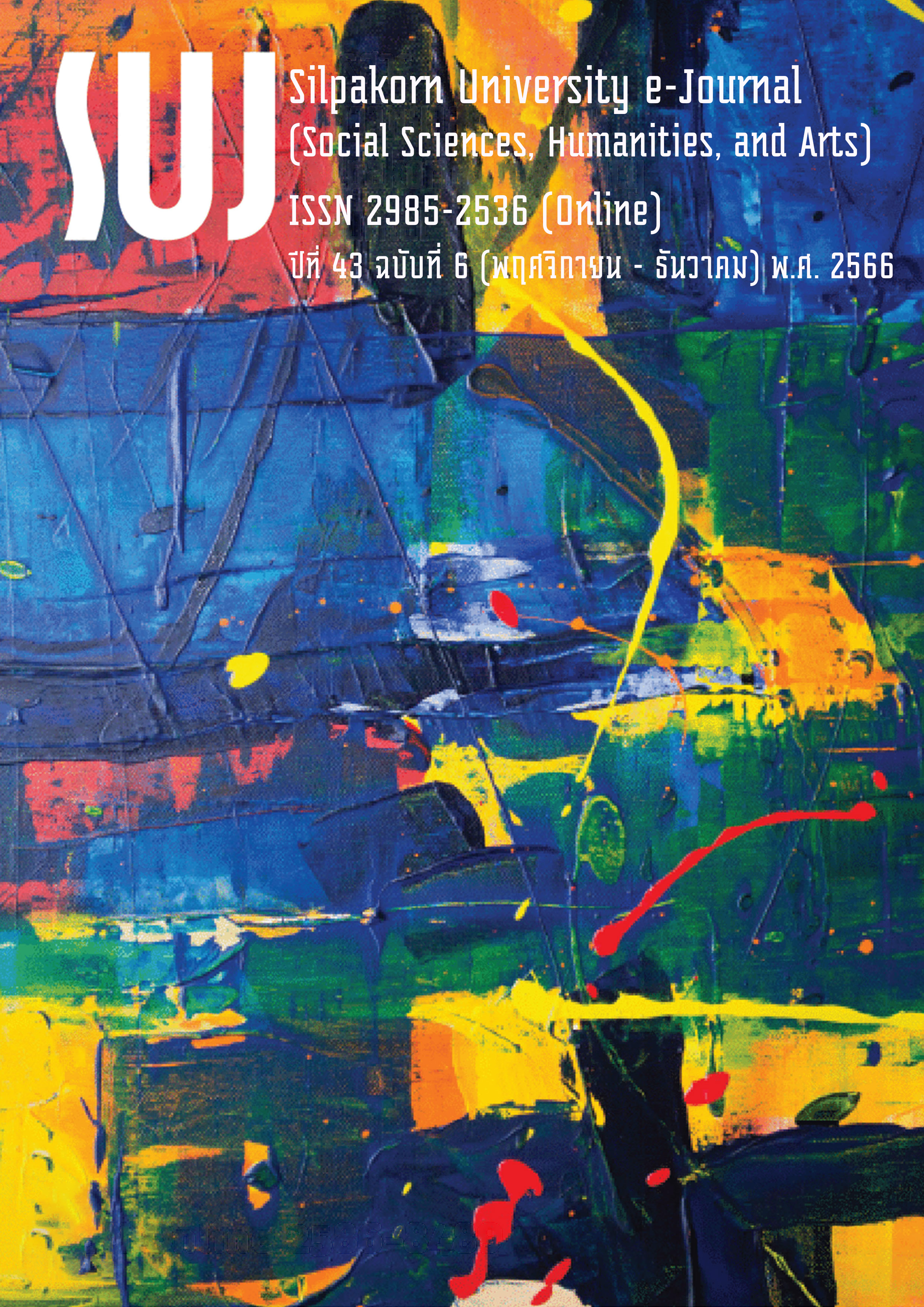เส้นทางและรูปแบบกิจกรรมการท่องเที่ยวเพื่อการเรียนรู้อย่างสร้างสรรค์ ตามรอยพ่อหลวงในจังหวัดเพชรบุรี (Tourism routes and activities for creative learning following the King’s Projects in Phetchaburi Province)
Main Article Content
Abstract
บทความวิจัยนี้มีวัตถุประสงค์เพื่อศึกษาเส้นทางและรูปแบบกิจกรรมการท่องเที่ยวตามรอยพ่อหลวง (รัชกาลที่ 9) เพื่อการเรียนรู้อย่างสร้างสรรค์จากโครงการอันเนื่องมาจากพระราชดำริต่าง ๆ ในจังหวัดเพชรบุรี เป็นการวิจัยเชิงปริมาณและคุณภาพ ซึ่งมีการเก็บรวบรวมข้อมูลโดยการสำรวจพื้นที่ ใช้แบบสอบถามรูปแบบกิจกรรมกับกลุ่มตัวอย่าง จำนวน 400 คน จากนั้นจึงสร้างและพัฒนารูปแบบกิจกรรมการท่องเที่ยว นำรูปแบบกิจกรรมดังกล่าวไปทดลองใช้ในพื้นที่ศึกษา และจัดสนทนากลุ่มตัวอย่างผู้ถูกเลือก จำนวน 9 คน เพื่อประเมินปรับปรุงรูปแบบกิจกรรม รวมทั้งหาแนวทางพัฒนาการท่องเที่ยวเพื่อให้เกิดการเรียนรู้อย่างสร้างสรรค์ ใช้การวิเคราะห์ข้อมูล 2 แบบ ได้แก่ การวิเคราะห์เนื้อหา และการวิเคราะห์ทางสถิติ ผลการวิจัย พบว่า 1) เส้นทางท่องเที่ยวและรูปแบบกิจกรรมการท่องเที่ยวตามรอยพ่อหลวงเพื่อการเรียนรู้ในจังหวัดเพชรบุรีอยู่ใกล้โครงการในพระราชดำริทั้งหมด 5 แห่ง และมีกิจกรรมการท่องเที่ยวและการเรียนรู้ที่หลากหลาย เช่น กิจกรรมการเรียนรู้ทางด้านการเกษตร กิจกรรมการอนุรักษ์ทรัพยากรธรรมชาติและสิ่งแวดล้อม เป็นต้น 2) สามารถเชื่อมโยงเส้นทางท่องเที่ยวได้ 2 เส้นทาง ได้แก่ เส้นทางท่องเที่ยวแบบไปเช้าเย็นกลับ โครงการศึกษาวิจัยและพัฒนาสิ่งแวดล้อมแหลมผักเบี้ยอันเนื่องมาจากพระราชดำริ - โครงการอนุรักษ์และฟื้นฟูสภาพพื้นที่บริเวณเขานางพันธุรัต (เขาเจ้าลายใหญ่) อันเนื่องมาจากพระราชดำริ - โครงการตามพระราชประสงค์หุบกะพง และเส้นทางท่องเที่ยวแบบไปเช้าเย็นกลับ โครงการชั่งหัวมันตามพระราชดำริ - โครงการศูนย์ศึกษาการพัฒนาห้วยทรายอันเนื่องมาจากพระราชดำริ 3) รูปแบบกิจกรรมการท่องเที่ยวที่พัฒนาขึ้นมา คือ SSKLC Model และ 4) มีแนวทางพัฒนาการท่องเที่ยว ได้แก่ เพิ่มการประชาสัมพันธ์ให้แหล่งท่องเที่ยวในโครงการอันเนื่องมาจากพระราชดำริให้เป็นที่รู้จักแก่นักท่องเที่ยวทั้งชาวไทยและชาวต่างชาติมากขึ้น ส่งเสริมให้นักท่องเที่ยวได้เข้าร่วมกิจกรรมการเรียนรู้มากขึ้น และเปิดโอกาสให้ชุมชนในพื้นที่ได้เข้ามามีส่วนร่วมในกิจกรรมการท่องเที่ยวมากขึ้น ผลที่ได้จากการวิจัยครั้งนี้จึงมีประโยชน์ต่อการส่งเสริมการพัฒนารูปแบบกิจกรรมการท่องเที่ยวเพื่อการเรียนรู้อย่างสร้างสรรค์และการท่องเที่ยวอย่างยั่งยืนของแหล่งท่องเที่ยวต่าง ๆ ในประเทศไทย
This research article aims to study the tourism routes and activities following the initiatives of King Rama IX in Phetchaburi Province. The research incorporates both quantitative and qualitative research methods, involving data collection through area surveys and activity-based questionnaires with a sample of 400 participants. A tourism activity model was developed and tested in the study area. A focus group of 9 people was used to evaluate and provide suggestions for the developed model. Data analysis encompassed content analysis and statistical analysis. The findings were as follows: 1) Tourism routes and activities following King Rama IX’s initiatives in Phetchaburi Province were located near all 5 royal projects. These offer a diverse range of tourism and learning activities, including agriculture learning and natural resources and environmental conservation activities, 2) Two integrated tourism routes were identified: a one-day trip from The King’s Royally Initiated Laem Phak Bia Environmental Research and Development Project to The Royal-initiated Nang Panthurat Mountain Area Conservation and Rehabilitation Project (Khao Chao Lai Yai) and Hubkapong Learning Center, in line with the Royal Intention; and a one-day trip from Chang Hua Man Royal Project to Huai Sai Royal Development Study Center, 3) A tourism activity model for creative learning following King Rama IX’s Projects, known as “SSKLC Model,” was developed, and 4) Suggestions for tourism development include increasing public relations efforts targeting both Thai and foreign tourists, promoting more learning activities and experiences for tourists, and involving local people and communities in tourism management. Therefore, the findings of this research are valuable for advancing the creation of tourism activity models that promote both creative learning and sustainable tourism across diverse tourist destinations in Thailand.
Downloads
Article Details

This work is licensed under a Creative Commons Attribution-NonCommercial-NoDerivatives 4.0 International License.
References
Best, J. W. (1981). Research in Education (4th ed.). NJ: Prentice Hall.
Chansawang, Rochaporn. (2003). Introduction to Tourism (ความรู้เบื้องต้นเกี่ยวกับการท่องเที่ยว). Nonthaburi: The Office of the University Press Sukhothai Thammathirat Open University.
Choibamroong, T. T. (2011). A Stakeholder Approach for Sustainable Community-based Rural Tourism Development in Thailand. In E. Laws, H. Richins, J. Agrusa, & N. Scott (Eds.), Tourist Destination Governance: Practice, Theory and Issues, (pp. 173-186). Oxon: CABI.
Cronbach, L. J. (1970). Essentials of Psychological Testing (3rd ed.). NY: Harper and Row.
Designated Areas for Sustainable Tourism Administration (Public Organization). (2017). Creative Tourism (การท่องเที่ยวเชิงสร้างสรรค์). [Online]. Retrieved July 10, 2018 from https://shorturl.at/oGTX3
Jittangwattana, Boonlert. (2005). Sustainable Tourism Development (การพัฒนาการท่องเที่ยวแบบยั่งยืน). Bangkok: Press and Design.
Kongsawat, Juthamas. (2007). The Promotion Study of Cultural Tourism at Uthong Suphan Buri Province (การศึกษาแนวทางการส่งเสริมการท่องเที่ยวเชิงวัฒนธรรมเมืองโบราณอู่ทอง จังหวัดสุพรรณบุรี). Master’s dissertation, Silpakorn University, Nakhon Pathom, Thailand.
Krejcie, R. V., & Morgan, D. W. (1970). Determining sample size for research activities. Educational and Psychological Measurement, 30(3): 607-610.
Mason, P. (1995). Tourism: Environment and Development Perspectives. Godalming: World Wide Fund for Nature.
Mathews, D. (1996). Elements of a Strong Civil Society and Healthy Public Life. Dayton, OH: Kettering Foundation.
Middleton, V. T. C., & Hawkins, R. (1998). Sustainable Tourism: A Marketing Perspective. Oxford: Butterworth-Heinemann.
Ministry of Tourism and Sports. (2011). National Tourism Development Plan 2012-2016 (แผนพัฒนาการท่องเที่ยวแห่งชาติ พ.ศ. 2555-2559). Bangkok: Ministry of Tourism and Sports.
Moutinho, L. (Ed.). (2000). Strategic Management in Tourism. Wallingford, Oxon: CABI.
Office of the National Economic and Social Development Board, Office of the Prime Minister. (2017). The Twelfth National Economic and Social Development Plan (2017-2021) (แผนพัฒนาเศรษฐกิจและสังคม แห่งชาติ พ.ศ. 2560-2564). [Online]. Retrieved July 10, 2018 from https://shorturl.at/pFMQU
Pattanapon, Prachyaporn. (2011). The Development of Cultural Tourism Route Along the Phetchaburi River (การพัฒนาเส้นทางท่องเที่ยววัฒนธรรมแม่น้ำเพชรบุรี). Master’s dissertation, Thammasat University, Bangkok, Thailand.
Phetchaburi Provincial Office. (2012). Province Information: General Information (ข้อมูลจังหวัด: ข้อมูลทั่วไป). Phetchaburi Province. [Online]. Retrieved July 10, 2018 from https://bit.ly/3QZaCNz
Phueakbuakhao, Wipavanee, & Phueakbuakhao, Saroj. (2018). Strategy for developing tourist attractions with participation of Phetchaburi Local Administration Organization based on philosophy of sufficiency economy (กลยุทธ์การพัฒนาแหล่งท่องเที่ยวโดยการมีส่วนร่วมขององค์กรปกครองส่วนท้องถิ่นจังหวัดเพชรบุรี บนฐานแนวคิดเศรษฐกิจพอเพียง). Veridian E-Journal, Silpakorn University (Humanities, Social Sciences and Arts), 11(2): 509-524.
Pianroj, Nontipak, Chodchuang, Siripat, & Ratcharak, Nattamon. (2015). Linking itinerary and tourism promotion program in the history and culture of the four provinces in Southern Thailand (การเชื่อมโยงเส้นทางและการส่งเสริมการตลาดโปรแกรมการท่องเที่ยวเชิงประวัติศาสตร์และวัฒนธรรมของกลุ่ม 4 จังหวัด ในภาคใต้ของประเทศไทย). Songklanakarin Journal of Management Sciences, 32(2): 89-115.
Wongwanich, Wanna. (2003). Geography of Tourism (ภูมิศาสตร์การท่องเที่ยว) (2nd ed.). Bangkok: Thammasat University Printing House.


